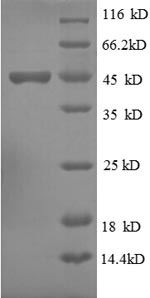Discover the superior quality of our Recombinant Human Isg15 protein, meticulously engineered for researchers focused on immunology. This full-length Ubiquitin-like protein ISG15 (Interferon-induced 15 kDa protein; Interferon-induced 17 kDa protein) is expressed in an E.coli system, covering the 2-157aa expression region to deliver the complete mature protein for your research needs. To facilitate purification and detection, the Isg15 protein features an N-terminal GST tag, ensuring consistent performance and reliable results in your experiments.
With a purity greater than 90% as determined by SDS-PAGE, our Recombinant Human Isg15 protein is available in both liquid and lyophilized powder forms. Trust in this high-quality protein to support your immunology research and provide dependable, reproducible outcomes.






